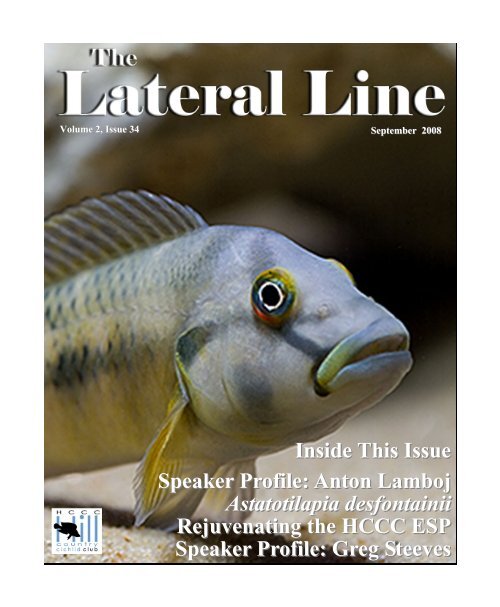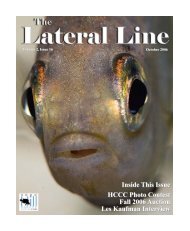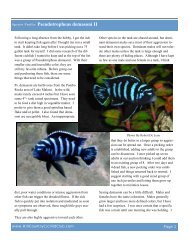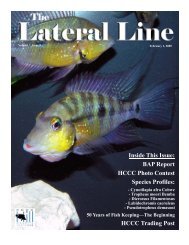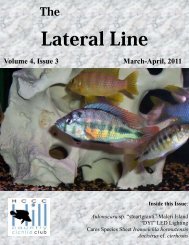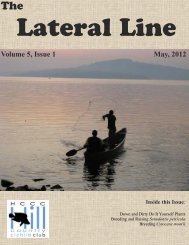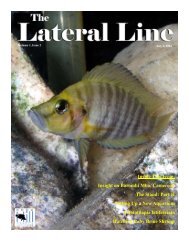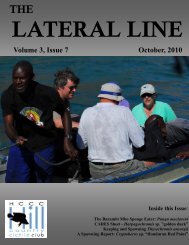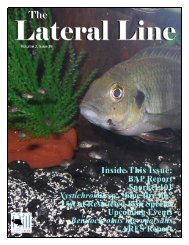August/September - Hill Country Cichlid Club
August/September - Hill Country Cichlid Club
August/September - Hill Country Cichlid Club
Create successful ePaper yourself
Turn your PDF publications into a flip-book with our unique Google optimized e-Paper software.
Volume 2, Issue 34 <strong>September</strong> 2008<br />
Inside This Issue<br />
Speaker Profile: Anton Lamboj<br />
Astatotilapia desfontainii<br />
Rejuvenating the HCCC ESP<br />
Speaker Profile: Greg Steeves
The Lateral Line Page 2<br />
BAP Report<br />
July was not as active as the previous month but still produced some<br />
“First Timers”. The very first entry for July was a “1 st Entry” for Dan<br />
(DanJay). It was a “Class C” entry of Ancistrus sp. “Brownie”. Just a<br />
few days later, Dan followed with another entry of Aulonocara jacobfreibergi.<br />
Congrats Dan on both of your entries.<br />
<strong>September</strong> 19, 2008<br />
INSIDE THIS<br />
ISSUE:<br />
Anton Lamboj 3<br />
Astatotilapia desfontainii 4<br />
Rejuvenating HCCC ESP 10<br />
Greg Steeves pt. 1 12<br />
“1st Entry” congratulations to Joseph (Joephish) with the Pseudotropheus<br />
saulosi. The fry are still available and being 7 months old already,<br />
it would be a very good BAP purchase. Congrats Joseph and<br />
keep them coming.<br />
Dan (Dan) adds to his BAP totals with the entry of Metriaclima<br />
lombardoi (kennyi). This entry also tacked on 5 bonus points to Kenneth<br />
Shelload for 2 nd generation points. Congrats Dan and keep up the<br />
good work.<br />
Congratulations to Greg (GAS) for adding two more entries to his<br />
BAP totals. One was the Aulonocara stuartgranti from Lake Malawi<br />
and the other was an Astatotilapia defontainii species. It originates<br />
from Tozeur Tunisia and made its way to Greg via Anton Lamboj.<br />
Not only is this a “1 st of species” but is also a “Class C”. Congrats<br />
Greg on a great entry and sorry members, no BAP fry on this one, but<br />
the article should be very informative.<br />
The first entry in <strong>August</strong> honors goes out to Greg with a nice species<br />
of Auloncara. Congratulations Greg (GAS) on your entry of the Auloncara<br />
stuartgranti.<br />
The second entry congrats goes to Robert (Ripple) on his entry of<br />
Paralabidochromis sp. "red fin piebald". Robert donated the fry but<br />
unfortunately lost the parents he was also donating. The parent donation<br />
would have given him a total of 400 points and put him in the<br />
Advanced Breeder category. However, now he is still 5 points shy.<br />
Cover Photo:<br />
Orthochromis<br />
stormsi<br />
By Dave Hansen<br />
A reminder for all the BAP members that last day for the entries is<br />
October 31 st.<br />
BAP totals on page 15<br />
■ Jim Beck
The Lateral Line Page 3<br />
Speaker Profile:<br />
Anton Lamboj<br />
<strong>Club</strong> Appearance:<br />
<strong>September</strong> 7-9th 2007<br />
(FOTAS).<br />
Anton presents some<br />
of the most exciting<br />
lectures I've had the<br />
privilege to attend.<br />
His expertise is only<br />
matched by his passion.<br />
The latter clearly<br />
fueling his drive towards<br />
his PhD in 1997 while working full time at<br />
the Austrian Railway Company. Along with his<br />
dissertation, "A Systematic Revision of the Genus<br />
Chromidotilapia", many published papers and<br />
articles, Anton literally wrote the book we all rely<br />
on. "The <strong>Cichlid</strong> Fishes of Western Africa"<br />
(2004) is the most comprehensive volume<br />
available today and is a must for seasoned Westie<br />
fans and novices alike. You'll see slides taken<br />
during his many collecting trips to various locales<br />
and hear wonderful stories of his experiences in<br />
these sometimes turbulent regions. He is unable to<br />
confine his enthusiasm to just pure academics, so<br />
he will also share many beautiful slides of the fish<br />
he keeps in the 50+ tanks in his basement. His<br />
animated discussions cover everything from the<br />
natural biotope to advice on maintaining these<br />
interesting and beautiful species in our home<br />
aquaria.<br />
If you run into Anton before or after the lecture,<br />
feel free to ask any questions about Westies, or<br />
about plants, birds, reptiles or any of the other<br />
things that fall under the umbrella that fascinates<br />
him, Life! Remember he is a biologist at heart and<br />
in soul. Many of us were amazed that he used his<br />
time between lectures during the 2007 FOTAS<br />
convention to field collect several samples of our<br />
local flora. I personally was impressed when he<br />
rolled up his sleeves and helped the small group<br />
of us setting up the show tanks. Anton's zeal has<br />
found a kinship in the members of the HCCC,<br />
"I've been to many conventions and club meetings,<br />
and I've seen a lot of real good ones<br />
(especially in the USA, you are doing great<br />
things, friends) - but the meeting in 2007 in San<br />
Antonio definitely was one of the three best I<br />
ever had in my life. It was a great time for me.<br />
You've got a fan!"<br />
Have a shot at pronouncing his last name correctly.<br />
He won't be offended by mistakes,<br />
chances are he's heard it before and takes it all in<br />
good humor! "It originally comes from the Scandinavian<br />
region, and [the pronunciation] is: The<br />
a of Lamboj like the o in "come" and boj like the<br />
english "boy". No problem with pronouncing my<br />
name wrong, it is very common wherever I go -<br />
even in Austria, as it is a more unusual and rare<br />
name. In the past I had such things as Lambosch,<br />
Lambos, Lambock, Lambay, and some more. So<br />
- I will see if the pronunciation part will help (or<br />
at least, which new versions it will bring......?)"<br />
Above all do not miss an opportunity to attend<br />
one of Anton's lectures. You'll be thoroughly<br />
entertained and amazed at what information<br />
you'll pick up. Since hearing one of his fervent<br />
side-discussions during a lecture, I've altered the<br />
way I feed my fish entirely! Who knows what<br />
tidbit we'll pick up next time!<br />
■ Nick Andreola
The Lateral Line Page 4<br />
Species Profile:<br />
Astatotilapia desfontainii<br />
Hailing from the North African countries of<br />
Algeria and Tunisia is a small, seldom seen<br />
cichlid, Astatotilapia desfontainii. Relating to<br />
its discovery, it would appear that this species<br />
was never known in great numbers even within<br />
its natural range. Of the five locations in which<br />
A. desfontainii has been recorded, four (Gafsa,<br />
Photo by Greg Steeves<br />
Tozeur, an oasis near Nefta, oasis En Nehmlet<br />
near Tozeur) occur in Tunisia and one unspecified<br />
site in Algeria (possibly Biskra) (Regan,<br />
1922). Unfortunately, water extraction from<br />
said locations for agricultural purposes has resulted<br />
in the expiration of A. desfontainii at<br />
Gafsa and Nefta. A 2006 expedition was able<br />
to locate the cichlid at Tozeur in an irrigation<br />
channel which also threatened (Schraml, 2006).<br />
As a result of this survey, A. desfontainii is<br />
included in the IUCN Red List of Threatened<br />
Species as endangered. In March of 2007, two<br />
Spanish ichthyolotsgists, José L. Blanco Barlés<br />
and Juan P. Campo Fort, were able to collect<br />
A. desfontainii at a hot springs resort near<br />
Tozeur. Here is was found with an introduced<br />
Gambusia species. From this collection, preserved<br />
specimens were sent to Sociedad de<br />
Estudios Ictiológicos (SEI) and the Museo<br />
Nacional de Ciencias Naturales (MNCCNN)<br />
in Madrid Spain. Live specimens were also<br />
collected and distributed to individuals in<br />
Europe and, to my good fortune, myself in the<br />
USA.<br />
In the initial description of the fish, Lacepède<br />
used two differing spellings. Desfontainii was<br />
the first name given followed by desfontainesi.<br />
Nearly a century later, the well known<br />
scientist George A. Boulenger attempted to<br />
refer to the species as desfontainesi (1899).<br />
Although all forms of the name appear over<br />
the years, the rules of species description<br />
clearly states that the premier name be given<br />
precedence thus, Astatotilapia desfontainii,<br />
whether or not what Lacepède intended, is the<br />
proper and accepted name of this cichlid.<br />
Astatotilapia desfontainii is a small cichlid of<br />
15cm. The base color of mature males is an<br />
AquaTek Tropical Fish<br />
a proud supporter of the HCCC<br />
10% off Fish<br />
8023 Burnet Rd. # 1<br />
Austin, TX 78132<br />
(512) 450-0182
The Lateral Line Page 5<br />
unassuming olive-green but each scale along<br />
the flank has a small dot of reflective and bright<br />
blue-green coloration. This color splash allows<br />
the fish to appear totally different depending on<br />
the angle positioned to a light source. The<br />
body is lined with 7-9 faint black bars. Near<br />
the top of the gill slit there is a black blotch<br />
surrounded by one or two orange flecks. A<br />
straight black bar runs diagonally through the<br />
Photo by Greg Steeves<br />
eye. The mouth is lined with bright blue lips.<br />
The dorsal fin has a black edging on the first<br />
three rays. The rays are dotted with red specks<br />
arranged in horizontal rows. The caudal fin is<br />
rounded with the same red flecks as seen in the<br />
dorsal. The first three rays of the pelvic fins<br />
are black. The remainder is transparent. A<br />
small number of ocelli (1-5) are positioned in<br />
the mid portion of the anal fin. These eggs<br />
spots are orange with a darker well defined<br />
orbit. These are located between, and not overlapping,<br />
the fin rays.<br />
Aquarium journal:<br />
I obtained my colony of six very small fry<br />
(approximately one month of age) in November<br />
of 2007. These were fry from wild parents<br />
collected at Tozeur Tunisia in the March 2007<br />
expedition. At this time they were placed in a<br />
45 gallon hexagonal tank filtered by a<br />
Aquaclear© 70 and a porous sponge placed<br />
over the intake. This was to prevent the small<br />
fish from being taken by the up flow of the<br />
filter opening. A small number of Steatocranus<br />
sp. "square head" of similar size shared<br />
these quarters. The substrate consisted of fine<br />
grain white pool filter sand. There was no<br />
heater in this tank and during that time of year<br />
the room is 21C. The natural range of Astatotilapia<br />
desfontainii in North Africa is known<br />
to reach temperatures below 18C (Schraml<br />
2006) thus A. desfontainii is capable of withstanding<br />
lower temperatures than many other<br />
familiar African cichlids.<br />
At the end of December 2007, the fry were<br />
moved to a 75 gallon tank. The tank was void<br />
of any décor. The filtration and substrate was<br />
transferred from the previous quarters so that<br />
minimal bacterial cycling would be needed.<br />
At this point, the young were fed crushed<br />
flake with twice weekly supplements of frozen<br />
mysis shrimp, brine shrimp or daphnia. The<br />
largest of the fry to this point was 2.5cm while<br />
the smallest slightly over 1.5cm. At this size,<br />
the two largest fry start to show blue speckling<br />
Darby’s Tropicals<br />
a proud supporter of the HCCC<br />
10% off Livestock & Plants<br />
5514 IH 35 South<br />
New Braunfels, TX 78132<br />
(830) 625-1122
The Lateral Line Page 6<br />
on the scales indicating that these are males.<br />
Males grow larger and at twice the rate of the<br />
females making sexing easy. In the bare tank<br />
there was not any noticeable aggression or territorial<br />
disputes.<br />
February 15th artificial plants were added to<br />
the 75 gallon aquaria. An albino Ancistrus<br />
species was added as well. Five of the six fish<br />
are growing rapidly while one has remained<br />
smaller than the others. The blue spangling on<br />
the two largest fish is becoming more pronounced.<br />
The largest female has several small<br />
nips out of her anal and caudal fins. I have not<br />
witnessed any aggression thus far at all. The<br />
largest male is two inches TL whilst the smallest<br />
A. defontainii in not yet an inch. The diet<br />
consists of freeze dried mosquito larvae, small<br />
general pellet food and the occasional feed of<br />
frozen brine shrimp and daphnia. Anton Lamboj<br />
also has fry from the same brood as mine<br />
and reports no breeding activity yet. His colony<br />
seems to be male heavy so it will be interesting<br />
to see if co spec aggression will play a<br />
role in their survival. I believe he maintains his<br />
colony with at least one other species of cichlid.<br />
Dave’s Rare Aquarium Fish<br />
a proud supporter of the HCCC<br />
5121 Crestway Drive Suite 300<br />
San Antonio, TX 78239 (210) 599-9444<br />
Member discounts<br />
www.DavesFish.com<br />
March 15th 2008 all six Astatotilapia defontainii<br />
are doing well. They have grown considerably<br />
in the past month. I am yet to witness<br />
signs of spawning activity. There is no<br />
noticeable co spec aggression. I find myself<br />
comparing these cichlids to the Lake Victoria<br />
mbipi that I have experience with. When<br />
young males begin to color, which is a sure<br />
Photo by Greg Steeves<br />
sign that spawning is soon to occur. The A.<br />
defontainii males have got a blue luminescence<br />
to the scales on the flanks however<br />
there are no noticeable and distinct coloration<br />
changes. The cichlids are still an overall<br />
shinny silver with faint patterning in the dorsal<br />
fin. The anal fin of the largest male has<br />
one distinct ocelli marking. The smallest<br />
of the colony is perhaps, 1/3 the size<br />
of the largest yet there appears to be no<br />
aggression directed at this individual, or<br />
any other member of the group. I am<br />
sure that the large tank size in comparison<br />
to the size and small number of fish<br />
has a lot to do with this.<br />
March 30th 2008 the largest A.
The Lateral Line Page 7<br />
defntainii is a definite male and has colored up<br />
nicely. The pelvic fins are black while red<br />
highlights can be seen in the dorsal, caudal and<br />
anal fins. The overall body coloration is olive<br />
green with the scales along the flanks tinged in<br />
blue and red. The largest male has been displaying<br />
to the smallest fish. This is done<br />
through a series of shimmies in an open area in<br />
the center of the tank. All fish are very active<br />
Photo by Greg Steeves<br />
and spend a lot of time sifting through the sand.<br />
The other A. defontainii do show the same<br />
gleaming scales as does the dominant male.<br />
The only thing lacking is size and the black<br />
Pet Frontier<br />
a proud supporter of the HCCC<br />
15% off total purchase<br />
excluding specials, package deals and sale items<br />
12315 Wetmore Rd.<br />
San Antonio, TX 78248<br />
(210) 653-8880<br />
pelvic fins. This cichlid is active but docile<br />
with co specs. No damage or deformities to<br />
any of the group.<br />
April 29th 2008. The A. defontainii spawned<br />
for the first time tonight. Last night the 2nd<br />
largest fish, obviously female, was very<br />
gravid with an ovipositor clearly protruding.<br />
Although I suspected spawning was near, I<br />
did not witness the male claiming a breeding<br />
territory or courting the female. The spawning<br />
site was under a decorative tree root. A<br />
small depression was made in the sand but it<br />
is unclear if the male excavated this area or<br />
the pit was created by the circular rotation in<br />
the act of spawning. The eggs are very small<br />
and opaque in color. The female expelled<br />
many eggs (est. 40) and the typical haplochromine-type<br />
spawn lasted for 35 minutes.<br />
After spawning, the female retreated to the top<br />
back corners of the tank and so far has not<br />
been overly harassed by the male. I am still<br />
unclear at what sex ratio I have with the six<br />
fish, only that there is at least one male and<br />
one female. I've decided to allow the female<br />
to hold in the community tank. If she is overly<br />
beleaguered I will move her to a brooding<br />
tank of her own.<br />
May 13th 2008. I had decided to leave the<br />
Lisa’s Lair Bookstore<br />
Online Books<br />
Various Discounts for<br />
HCCC Members<br />
www.lisaslairbookstore.com
The Lateral Line Page 8<br />
Astatotilapia defontainii<br />
spawn<br />
Photos by Greg Steeves
The Lateral Line Page 9<br />
holding female in the community tank she<br />
spawned in. The male did not overly harass<br />
her (infrequently he would take a run at her as<br />
he did to every other fish in the aquarium) as<br />
she spent the majority of her time hovering<br />
towards the top of the tank along a short side.<br />
Not knowing the gestation period, but assuming<br />
it was the same as most other haplochromine<br />
type I have had experience with, I<br />
decided to strip her on May 13th, exactly 2<br />
weeks after spawning. I had a tumbler ready to<br />
incubate the fry that I had expected to still have<br />
a yolk sac. I easily netted the holding female<br />
and gently pried open her mouth with a loop in<br />
the mesh of the net. She spat 10 fry. I flushed<br />
her mouth gently with a turkey baster and one<br />
more fry gushed out. The tiny fry are free<br />
swimming and had no yolk sac left. They were<br />
placed in a 20 gallon high tank and the mother<br />
was returned to the main tank. This one small<br />
spawn nearly tripled the number of Astatotilapia<br />
defontainii in the US now. Hopefully another<br />
spawn will occur soon.<br />
<strong>August</strong> 10th 2008. Another Astatotilapia defontainii<br />
spawn. The male brilliantly colored<br />
for the past three days as he excavated sand<br />
from three different areas around the tank. The<br />
male frantically displayed to the obviously ripe<br />
female for days before she finally succumbed<br />
to his advances. Spawning occurred in the<br />
period of about half an hour. I removed the<br />
male after this spawning due to incessant chasing<br />
of the female (wanting to continue spawning).<br />
Spawning occurred in each of the three<br />
pits the male had dug.<br />
<strong>August</strong> 13th 2008. Once the male was separated,<br />
the holding female took over as alpha<br />
fish of the tank. She is quite aggressive to the<br />
other A. defontainii that come near her as well<br />
as the other inhabitants including Limbochromis<br />
robertsi, Steatocranus sp. "square<br />
head" and a dozen young Ancistrius sp. She is<br />
still holding what looks to be a good brood. I<br />
will be setting up a tank inside for the fry.<br />
In conversations with Dr Lamboj I was sadden<br />
to hear that he had lost all but a lone female to<br />
his Astatotilapia defontainii colony. I hope<br />
that I will be successful enough with these<br />
cichlids to return some offspring to him. I<br />
feel that once I have enough young to distribute<br />
to HCCC members, the horribly bleak<br />
future of this cichlid will be much brighter.<br />
References:<br />
Blanco, José Luis. Field notes from expedition<br />
to Tunisia, 2007.<br />
Schraml, E. 2006. Haplochromis desfontainii.<br />
In: IUCN 2007. 2007 IUCN Red List of<br />
Threatened Species. <br />
■ Greg Steeves<br />
The Hobby Palace<br />
a proud supporter of the HCCC<br />
10% off selected items<br />
5305 Bolm Road #3<br />
Austin, TX<br />
(512) 389-3833
The Lateral Line Page 10<br />
<strong>Club</strong> Project:<br />
Rejuvenating the HCCC ESP<br />
"Grandpa, what is a cichlid?" a tiny voice asks.<br />
"You mean, what was a cichlid," you reply.<br />
"They're GONE? All of them?" the tiny voice<br />
exclaims, "Why? How?"<br />
Photo by Dave Hansen<br />
Now there is a conversation that I hope never<br />
has to take place. Wouldn't it be a tragedy for<br />
future generations not to get to see these beautiful<br />
fish. Imagine that was your grandchild<br />
asking that question. How would you like to<br />
answer? Although it is probably not likely that<br />
all the cichlids will become extinct, there is an<br />
alarming number of species that are at severe<br />
risk. Even more alarming are the number of<br />
species that are reported as extinct by researchers.<br />
No one can account for the disappearance<br />
of any undiscovered species, so the real number<br />
that are gone is even greater. Seeing so<br />
many in the fish stores makes one assume that<br />
they are in bountiful supply so the wild populations<br />
must be thriving. Right?<br />
Unfortunately, that is as far as I took the<br />
thought for many years. I shudder to think<br />
how many species have disappeared from the<br />
lakes since I first entered the hobby. Even<br />
more disappointing is knowing that I<br />
could have been playing an active role<br />
in the survival of my favorite fishes all<br />
that time but did nothing.<br />
I'm not talking about setting up camp<br />
on the shores of Lake Victoria and<br />
propagating fish, although that would<br />
be awesome. I'm talking about the<br />
HCCC Endangered Species Program.<br />
The ESP is really cool and anyone can<br />
participate. You need not be a paying<br />
club member, just a registered HCCC<br />
forum user. Many already have colonies<br />
setup in the database and have recorded<br />
journal entries and posted photos. This is an<br />
excellent program that needs some rejuvenation.<br />
Since my fish room contains a good<br />
number of species on the ESP list, I've decided<br />
to dedicate myself to this project and it's<br />
Leslie’s Pool Supply<br />
a proud supporter of the HCCC<br />
20% off Pool Supplies<br />
5-20% off selected items<br />
All Locations<br />
Test kits and Pond Supplies
The Lateral Line Page 11<br />
expansion. I have the time available to do quite<br />
a bit with the program and here are a few<br />
things I hope to accomplish:<br />
1. Distribute a regular newsletter on the program.<br />
It will highlight some species, notify<br />
of new colonies added, notify of any species<br />
added to the list, notify of conservation<br />
efforts related to ESP, etc.<br />
2. Keep an active journal on my endangered<br />
species colonies.<br />
3. Write species articles for the program<br />
documenting the hopeful spawning of my<br />
colonies.<br />
4. Post some good shots of my fish, both<br />
male and female.<br />
5. Create downloadable content for the ESP<br />
participants. Maybe a journal log you<br />
could print out to record events in the fish<br />
room and take to the computer to update<br />
journals would be handy. How about a<br />
Water parameter log? I'm looking to create<br />
things that would make recording the data<br />
to post easier.<br />
6. Develop some sort of way to recognize<br />
your efforts. An award of some sort<br />
maybe. I'm not really sure what we<br />
could do but I'm looking into it further.<br />
I'm also looking for any ideas that anyone<br />
may have for making it easier to participate<br />
or anything that you think would be helpful<br />
to the program. I'll look into every idea and<br />
see what can be done. Just log on to the<br />
forum and PM me. One of the biggest<br />
things you can do to help is to register your<br />
species and keep an active journal. In doing so<br />
you will help all others who are interested in<br />
starting a colony and are seeking info on<br />
keeping the fish.<br />
There has already been a huge amount of<br />
work done by others to get the ESP off the<br />
ground. They should be very proud of their<br />
efforts as should all who participate in the<br />
program. All I want to try to do is take this to<br />
the next level. The mission of the program has<br />
not changed nor would I dream of trying. It is<br />
a most worthy cause. That is not to say that it<br />
should not evolve. There are already some<br />
exciting things brewing that I don't have<br />
enough information to report on, but it will<br />
bring the HCCC some more national attention<br />
as a club that cares. So go update your journals<br />
and register your colonies now. You don't<br />
want to be left out when all eyes are on the<br />
HCCC's ESP!<br />
Peace.<br />
Amazonia International<br />
a proud supporter of the HCCC<br />
■ Troy Vetrop<br />
Member discounts:<br />
20% off Fish & Live Plants<br />
10% off Tanks, Stands, Eheims & Eclipses<br />
25% off Filters & Powerheads<br />
4631 Airport #116 Austin, TX<br />
(512) 451-0958
The Lateral Line Page 12<br />
Speaker Profile:<br />
Greg Steeves pt. 1<br />
Greg Steeves,<br />
originally from<br />
New Brunswick,<br />
Canada, resides<br />
now in San Antonio,<br />
Texas, is one<br />
of the founding<br />
members of <strong>Hill</strong><br />
<strong>Country</strong> <strong>Cichlid</strong><br />
<strong>Club</strong>. Greg is well<br />
known in the state<br />
as a cichlid specialist<br />
when dealing with Lake Victoria cichlids,<br />
speaker, photographer, and extremely<br />
gifted writer of many local articles. Greg's<br />
spends his time divided among his family,<br />
work, and friends and of course cichlids. (I<br />
believe the fish get their share of the attention,<br />
if you have ever seen his "fish room").<br />
Jim: Greg, I wish to thank you very much for<br />
granting me this interview. To start, since you<br />
are originally from Canada did your interest in<br />
aquarium fish originate there or after you<br />
made your residence in the United States. And<br />
what was in your first tank?<br />
Greg: I've been a hobbyist for as long as I can<br />
remember. I went through a spell in my teens<br />
where I would keep native maritime fish like<br />
brook trout, salmon parr, chubs and sticklebacks<br />
(still a favorite of mine). It was with<br />
seven spine sticklebacks that I got to see first<br />
hand how incredible and varied the reproductive<br />
strategy of fish were. I went through the<br />
normal guppy, molly, barb, tetra thing early on<br />
but outgrew that rather quickly.<br />
Jim: When did you migrate to the US?<br />
Greg: Lee Ann and I began my immigration<br />
process in 1999. After three years of bureaucratic<br />
insanity, I was given my visa in 2002<br />
and moved here Memorial Day weekend of<br />
that year.<br />
Jim: How many tanks and what species did<br />
you amass before coming to the US?<br />
Greg: At my peak I had somewhere in the<br />
area of 100 aquariums at about 2000 gallons<br />
and kept exclusively cichlids. I had a lot of<br />
Mbuna simply because that was pretty much<br />
all that was available up north at the time.<br />
Lee Ann would come up to visit fairly frequently<br />
and always bring me a crate or two of<br />
cichlids. At that time she was doing some<br />
work for Armke’s Rare Aquarium Fish so I<br />
was keeping a lot of fish that had not been<br />
even brought into Canada at that time.<br />
Jim: How many tanks do you have now?<br />
Greg: We've scaled back a bit but still operate<br />
nearly 100 tanks and pools. The insanity continues.<br />
Jim: How and when did you become avid<br />
aquarists and was <strong>Cichlid</strong>s your first attraction<br />
or was it fish in general?<br />
Greg: Early on, my initial interests were all<br />
fish. Usually anything that caught my eye at<br />
the local aquarium shop. I really enjoyed the<br />
unusual such as African butterfly fish, eels,<br />
and creatures that were “different”. I eventu-
The Lateral Line Page 13<br />
ally found my way to cichlids in the form of<br />
Hemichromis bimaculats (the common jewel<br />
cichlid). These normally brown fish one day<br />
turned bright red and much to my surprise, I<br />
found a pair guarding a rock that was covered<br />
with eggs. After that experience, I was hooked<br />
on cichlids. After discovering the diversity<br />
within this family, my aquarium collection<br />
went from three or four tanks to a full fledge<br />
fish hut with over 100 tanks. The stories of<br />
fish keeping in an out building, when it was -<br />
40F for weeks at a time, could fill a book.<br />
Jim: Greg, your are one of the founding members<br />
of the <strong>Hill</strong> <strong>Country</strong> <strong>Cichlid</strong> <strong>Club</strong> which is<br />
govern by a Leadership Group that has been<br />
very successful in its first four years of operation.<br />
Could you tell me something about the<br />
club?<br />
Greg: I consider the <strong>Hill</strong> <strong>Country</strong> <strong>Cichlid</strong> <strong>Club</strong><br />
to be one of the finest organizations I’ve ever<br />
been involve with. We were no more than a<br />
few friends who eventually met together at our<br />
house as just a get together. I think that was in<br />
November of 2002. It was immediately evident<br />
that, because we had such a great time,<br />
that we would have to do this on a regular basis.<br />
This was the early formation of our club.<br />
There have been other aquarium clubs in this<br />
area in the past but unfortunately all eventually<br />
dissolved because of personality conflicts. We<br />
decided that if we wanted long term success<br />
that we would have to try something different.<br />
The seven people that were part of that first<br />
meeting eventually became the leadership<br />
group. In this manner, no matter how many<br />
others joined our club, there would always be a<br />
core group that would keep things going even<br />
if it meant some turmoil threatened breaking it<br />
up. This has evolved over time as leadership<br />
members have come and gone (these members<br />
become club elders) but the idea of a core<br />
group has remained. That is not to say that the<br />
average member has no say in club affairs, in<br />
fact, quite the opposite. All HCCC members<br />
are encouraged to take part in every aspect of<br />
our club. Another wonderful decision made<br />
early on was not to run the club as a business<br />
but rather keep the social family oriented aspect<br />
to things as best we could. We have had<br />
ebbs and tides of activity but I feel we have a<br />
very strong organization with a wonderful<br />
membership.<br />
Jim: Did you belong to any fish clubs before<br />
you began the <strong>Hill</strong> <strong>Country</strong> <strong>Cichlid</strong> <strong>Club</strong><br />
(HCCC) here in the US or Canada?<br />
Greg: I was lucky enough to visit here many<br />
times before I actually moved to Texas and as<br />
such, I was able to attend a couple CASA<br />
(<strong>Cichlid</strong> Association of San Antonio) auctions<br />
and although Lee Ann and some of my southern<br />
friends were members, I was not. I was a<br />
member of CRLCA (Canadian Rift Lake<br />
<strong>Cichlid</strong> Association) which sadly turned out to<br />
be a scam organization and later was a director<br />
with the CCA (Canadian <strong>Cichlid</strong> Association).<br />
Jim: Besides HCCC, ACA, HAS, TCA, what<br />
other organizations are you affiliated with?<br />
Greg: A couple of years ago I had the good<br />
fortune of meeting up with Claudia Dickinson.<br />
She is fantastic author and ACA members<br />
know her as editor of the Buntbarsche<br />
Bulletin. Through her I’ve gotten involved
The Lateral Line Page 14<br />
with the C.A.R.E.S. (Conservation Awareness<br />
Recognition Encouragement Support), preservation<br />
program. Presently I’ve become involved<br />
with a cichlid conservation project centered<br />
in Kenya called the Lake Victoria Conservation<br />
through Education Project. This involved<br />
providing aquariums for schools around<br />
Lake Victoria. Here they maintain their native<br />
cichlids. This shows the students the treasures<br />
in their backyard. We are networking these<br />
efforts with schools in the US so even though<br />
the project is still in its infancy, progress has<br />
been very exciting. I am hoping that in the<br />
near future that time will permit me to assist<br />
with FOTAS (Federation of Texas Aquarium<br />
Societies) operations further than being an<br />
HCCC delegate.<br />
Jim: Does your family share your passion for<br />
fish, and do they participate?<br />
Greg: My wife, Lee Ann is well known to<br />
HCCC members. She is as much a participant<br />
in the aquarium hobby as I am. Of our children,<br />
Karli, Stuart and Erin, it is Stuart that I<br />
think will take an active roll in aquatics. Karli<br />
has been around my fascination with cichlids<br />
all her life, its old news for her. Stuart got to<br />
spend a little time with Ad Konings and Anton<br />
Lamboj and has read their books from cover to<br />
cover. They were both a very positive influence<br />
on him. He really enjoys going to the fish<br />
lectures and works with Diane at the front table<br />
of HCCC auctions. Erin has not shown an interest<br />
in cichlids yet but I hope that will<br />
change. I don’t want to force this on them but<br />
you bet I will encourage any enthusiasm that<br />
they might show.<br />
Jim: Greg you are well known for your knowledge<br />
of <strong>Cichlid</strong>s especially Victorians and for<br />
your writing skills. Just recently you ventured<br />
in to producing some video clips. Would you<br />
tell us about your equipment and interests?<br />
Greg: I do enjoy writing on subjects that there<br />
is very little information available on. In<br />
some way I hope that writing about my experiences<br />
with a cichlid species might help<br />
someone else down the line. It was evident to<br />
me shortly after meeting Dave Hansen that I<br />
was not going to be able to capture my fish in<br />
the manner his photographs do. I will leave<br />
the picture taking to him and others. I decided<br />
to try and capture video footage as a way of<br />
getting these fish out there. I’ve still got a lot<br />
to learn but I do love the interactive aspect of<br />
video. I have a Sony digital camcorder that<br />
will be upgraded to a digital HD camera eventually.<br />
I built a computer system specifically<br />
designed for converting raw video to a format<br />
that I could share with others on the web.<br />
This has been a lot of fun for me. I’m getting<br />
a little better at things with each capture. Lee<br />
Ann and the kids gave me an underwater camera<br />
for father’s day this year as well. I’ve<br />
been having fun getting footage of my pond<br />
fish and I’m really enjoying getting back into<br />
snorkeling. There are so many excellent spots<br />
around here for that and being able to film<br />
what I see underwater is a huge added bonus.<br />
Continued next issue.<br />
■ Jim Beck
The Lateral Line Page 15<br />
Event Calendar:<br />
Upcoming Events in Texas<br />
<strong>September</strong><br />
<strong>September</strong> 26th—28th<br />
Federation of Texas Aquarium Societies—<br />
Hosted by the Texas <strong>Cichlid</strong> Association.<br />
Celebrating 25 years! Hilton Garden Inn DFW<br />
South, 2001 Valley View Lane, Irving, Texas.<br />
Featured speakers include Ad Konings, Jeff<br />
Cardwell, Gary Lang and Barbie Fiorentino.<br />
Visit www.texascichlid.org for more information.<br />
October<br />
October 11th<br />
Texas <strong>Cichlid</strong> Association—Regular monthly<br />
meeting, 7:00 pm at Alan Young's house, 1201<br />
2008 BAP Standings<br />
Name<br />
YTD<br />
Dan S. 275<br />
Nick 230<br />
Pat 90<br />
Greg 75<br />
Mike 45<br />
Robert D. 55<br />
Dan I 35<br />
Duc 25<br />
Jerry 25<br />
Evan 20<br />
Brookvalley in Arlington (817) 467-9739.<br />
October 26th<br />
<strong>Hill</strong> <strong>Country</strong> <strong>Cichlid</strong> <strong>Club</strong>—Aquarena<br />
Springs trip. More details as they become<br />
available - www.hillcountrycichlidclub.com.<br />
December<br />
December 6th<br />
<strong>Hill</strong> <strong>Country</strong> <strong>Cichlid</strong> <strong>Club</strong>—Christmas party.<br />
Special Guest Anton Lamboj. For more information<br />
visit www.hillcountrycichlidclub.com<br />
in to coming weeks.<br />
December<br />
Texas <strong>Cichlid</strong> Association—Christmas party.<br />
Date and time to be announced.<br />
2008 BAP Standings (cont.)<br />
Name<br />
YTD<br />
Robert T. 20<br />
Drew 15<br />
Ed 15<br />
JB 15<br />
Lisa Br. 15<br />
Joseph 15<br />
Christy 5<br />
Jim B. 5<br />
Kenneth 5
The Lateral Line<br />
Official Publication of the<br />
<strong>Hill</strong> <strong>Country</strong> <strong>Cichlid</strong> <strong>Club</strong>


